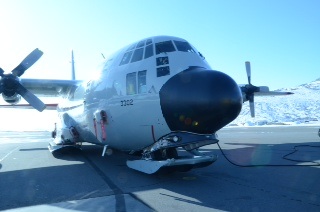
Much rides on how fast ice sheets in Antarctica and Greenland melt. If they melt entirely, the combined volume of these two ice sheets would raise the sea level by more than 200 feet. Of course theres little chance of that happening in the foreseeable future, but they are shrinking and scientists want to know how fast.
In the 1990s, a glacier in western Greenland called Jakobshavn, where ice from the Greenland Ice Sheet flows into the ocean, suddenly doubled its flow. It became the worlds fastest flowing glacier. Pieces of ice weighing between a hundred million and a billion tons now break off the ice sheet regularly and float into the north Atlantic.
I flew to Greenland today to join a NASA mission to study changes in the Greenland Ice Sheet. I began at Stratton Air National Guard Base in Schenectady, New York, the home of a fleet of LC-130 turbo prop planes that flies scientists to Greenland and Antarctica. The plane I flew in was built in 1976, when I was still in high school. The stubby four-engine plane is all about getting a job done. The comfort of its passengers is not even a second thought. A few civilians, including a couple of ice researchers, joined a squadron of military men and women on the flight. We sat on cot-like benches arranged down the length of the fuselage and reclined against a grid of nylon webbing. We flew for hours over tree-covered humps amid white, featureless, snow-burdened rivers and lakes of northern Canada. Then, across Davis Strait, we saw the Greenland Ice Sheet, a brilliant cake of ice, lapping at the steel-blue sea. Our destination, Kangerlussuaq, was just inland.
Tomorrow, I will fly low over the ice sheet on a P-3b airplane loaded with electronic gear. The research plane will carry more than a dozen scientists overseeing eight instruments focused on the ice sheet. Theyll swoop down over the Jakobshavn glacier, seeking clues to what caused it to speed up in the past and what it might do in the future.
Support our work
Your support ensures great journalism and education on underreported and systemic global issues

